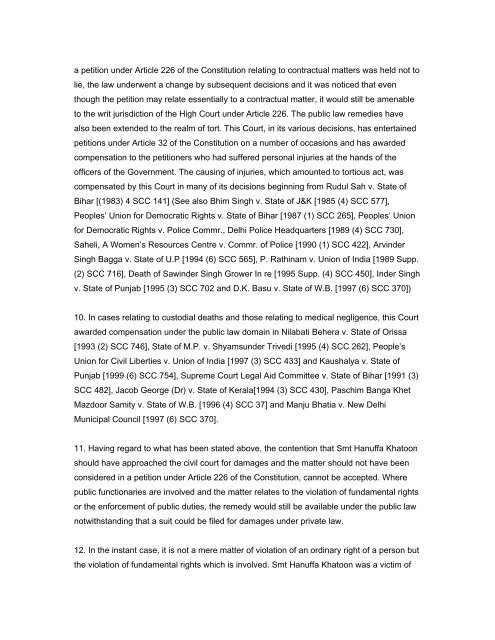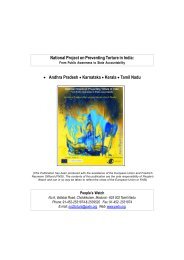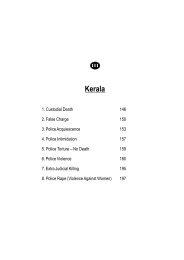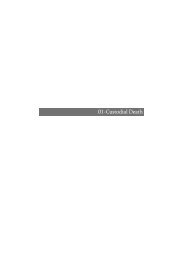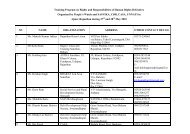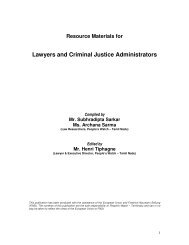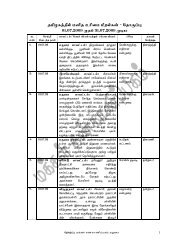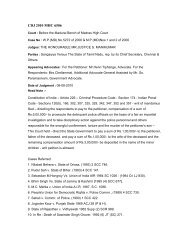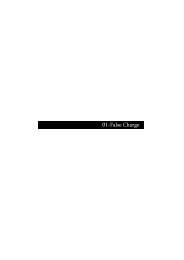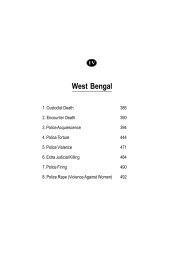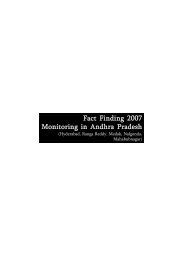Eswaran -Judgment CDJ 2010 MHC 6929.pdf - People's watch
Eswaran -Judgment CDJ 2010 MHC 6929.pdf - People's watch
Eswaran -Judgment CDJ 2010 MHC 6929.pdf - People's watch
Create successful ePaper yourself
Turn your PDF publications into a flip-book with our unique Google optimized e-Paper software.
a petition under Article 226 of the Constitution relating to contractual matters was held not to<br />
lie, the law underwent a change by subsequent decisions and it was noticed that even<br />
though the petition may relate essentially to a contractual matter, it would still be amenable<br />
to the writ jurisdiction of the High Court under Article 226. The public law remedies have<br />
also been extended to the realm of tort. This Court, in its various decisions, has entertained<br />
petitions under Article 32 of the Constitution on a number of occasions and has awarded<br />
compensation to the petitioners who had suffered personal injuries at the hands of the<br />
officers of the Government. The causing of injuries, which amounted to tortious act, was<br />
compensated by this Court in many of its decisions beginning from Rudul Sah v. State of<br />
Bihar [(1983) 4 SCC 141] (See also Bhim Singh v. State of J&K [1985 (4) SCC 577],<br />
Peoples’ Union for Democratic Rights v. State of Bihar [1987 (1) SCC 265], Peoples’ Union<br />
for Democratic Rights v. Police Commr., Delhi Police Headquarters [1989 (4) SCC 730],<br />
Saheli, A Women’s Resources Centre v. Commr. of Police [1990 (1) SCC 422], Arvinder<br />
Singh Bagga v. State of U.P [1994 (6) SCC 565], P. Rathinam v. Union of India [1989 Supp.<br />
(2) SCC 716], Death of Sawinder Singh Grower In re [1995 Supp. (4) SCC 450], Inder Singh<br />
v. State of Punjab [1995 (3) SCC 702 and D.K. Basu v. State of W.B. [1997 (6) SCC 370])<br />
10. In cases relating to custodial deaths and those relating to medical negligence, this Court<br />
awarded compensation under the public law domain in Nilabati Behera v. State of Orissa<br />
[1993 (2) SCC 746], State of M.P. v. Shyamsunder Trivedi [1995 (4) SCC 262], People’s<br />
Union for Civil Liberties v. Union of India [1997 (3) SCC 433] and Kaushalya v. State of<br />
Punjab [1999 (6) SCC 754], Supreme Court Legal Aid Committee v. State of Bihar [1991 (3)<br />
SCC 482], Jacob George (Dr) v. State of Kerala[1994 (3) SCC 430], Paschim Banga Khet<br />
Mazdoor Samity v. State of W.B. [1996 (4) SCC 37] and Manju Bhatia v. New Delhi<br />
Municipal Council [1997 (6) SCC 370].<br />
11. Having regard to what has been stated above, the contention that Smt Hanuffa Khatoon<br />
should have approached the civil court for damages and the matter should not have been<br />
considered in a petition under Article 226 of the Constitution, cannot be accepted. Where<br />
public functionaries are involved and the matter relates to the violation of fundamental rights<br />
or the enforcement of public duties, the remedy would still be available under the public law<br />
notwithstanding that a suit could be filed for damages under private law.<br />
12. In the instant case, it is not a mere matter of violation of an ordinary right of a person but<br />
the violation of fundamental rights which is involved. Smt Hanuffa Khatoon was a victim of


